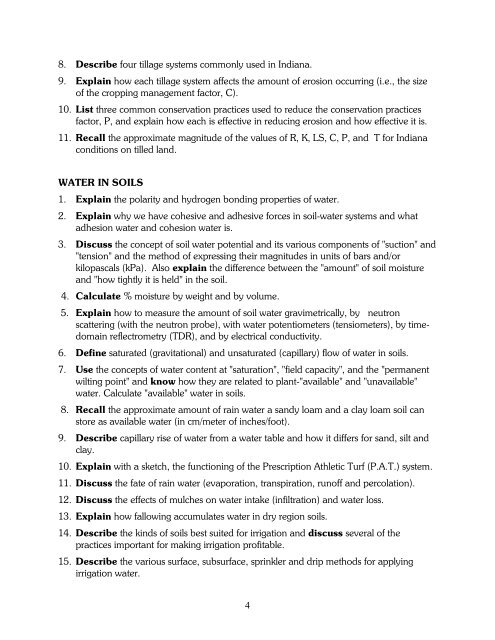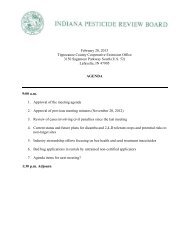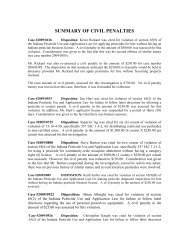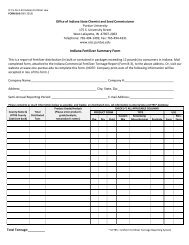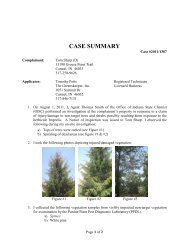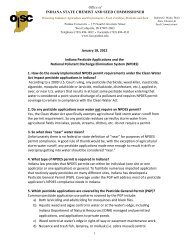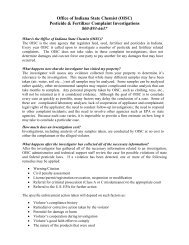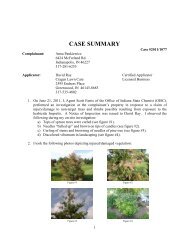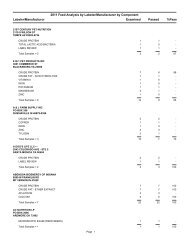Indiana Registry of Soil Scientists Performance Objectives for the ...
Indiana Registry of Soil Scientists Performance Objectives for the ...
Indiana Registry of Soil Scientists Performance Objectives for the ...
You also want an ePaper? Increase the reach of your titles
YUMPU automatically turns print PDFs into web optimized ePapers that Google loves.
8. Describe four tillage systems commonly used in <strong>Indiana</strong>.<br />
9. Explain how each tillage system affects <strong>the</strong> amount <strong>of</strong> erosion occurring (i.e., <strong>the</strong> size<br />
<strong>of</strong> <strong>the</strong> cropping management factor, C).<br />
10. List three common conservation practices used to reduce <strong>the</strong> conservation practices<br />
factor, P, and explain how each is effective in reducing erosion and how effective it is.<br />
11. Recall <strong>the</strong> approximate magnitude <strong>of</strong> <strong>the</strong> values <strong>of</strong> R, K, LS, C, P, and T <strong>for</strong> <strong>Indiana</strong><br />
conditions on tilled land.<br />
WATER IN SOILS<br />
1. Explain <strong>the</strong> polarity and hydrogen bonding properties <strong>of</strong> water.<br />
2. Explain why we have cohesive and adhesive <strong>for</strong>ces in soil-water systems and what<br />
adhesion water and cohesion water is.<br />
3. Discuss <strong>the</strong> concept <strong>of</strong> soil water potential and its various components <strong>of</strong> "suction" and<br />
"tension" and <strong>the</strong> method <strong>of</strong> expressing <strong>the</strong>ir magnitudes in units <strong>of</strong> bars and/or<br />
kilopascals (kPa). Also explain <strong>the</strong> difference between <strong>the</strong> "amount" <strong>of</strong> soil moisture<br />
and "how tightly it is held" in <strong>the</strong> soil.<br />
4. Calculate % moisture by weight and by volume.<br />
5. Explain how to measure <strong>the</strong> amount <strong>of</strong> soil water gravimetrically, by neutron<br />
scattering (with <strong>the</strong> neutron probe), with water potentiometers (tensiometers), by timedomain<br />
reflectrometry (TDR), and by electrical conductivity.<br />
6. Define saturated (gravitational) and unsaturated (capillary) flow <strong>of</strong> water in soils.<br />
7. Use <strong>the</strong> concepts <strong>of</strong> water content at "saturation", "field capacity", and <strong>the</strong> "permanent<br />
wilting point" and know how <strong>the</strong>y are related to plant-"available" and "unavailable"<br />
water. Calculate "available" water in soils.<br />
8. Recall <strong>the</strong> approximate amount <strong>of</strong> rain water a sandy loam and a clay loam soil can<br />
store as available water (in cm/meter <strong>of</strong> inches/foot).<br />
9. Describe capillary rise <strong>of</strong> water from a water table and how it differs <strong>for</strong> sand, silt and<br />
clay.<br />
10. Explain with a sketch, <strong>the</strong> functioning <strong>of</strong> <strong>the</strong> Prescription Athletic Turf (P.A.T.) system.<br />
11. Discuss <strong>the</strong> fate <strong>of</strong> rain water (evaporation, transpiration, run<strong>of</strong>f and percolation).<br />
12. Discuss <strong>the</strong> effects <strong>of</strong> mulches on water intake (infiltration) and water loss.<br />
13. Explain how fallowing accumulates water in dry region soils.<br />
14. Describe <strong>the</strong> kinds <strong>of</strong> soils best suited <strong>for</strong> irrigation and discuss several <strong>of</strong> <strong>the</strong><br />
practices important <strong>for</strong> making irrigation pr<strong>of</strong>itable.<br />
15. Describe <strong>the</strong> various surface, subsurface, sprinkler and drip methods <strong>for</strong> applying<br />
irrigation water.<br />
4


